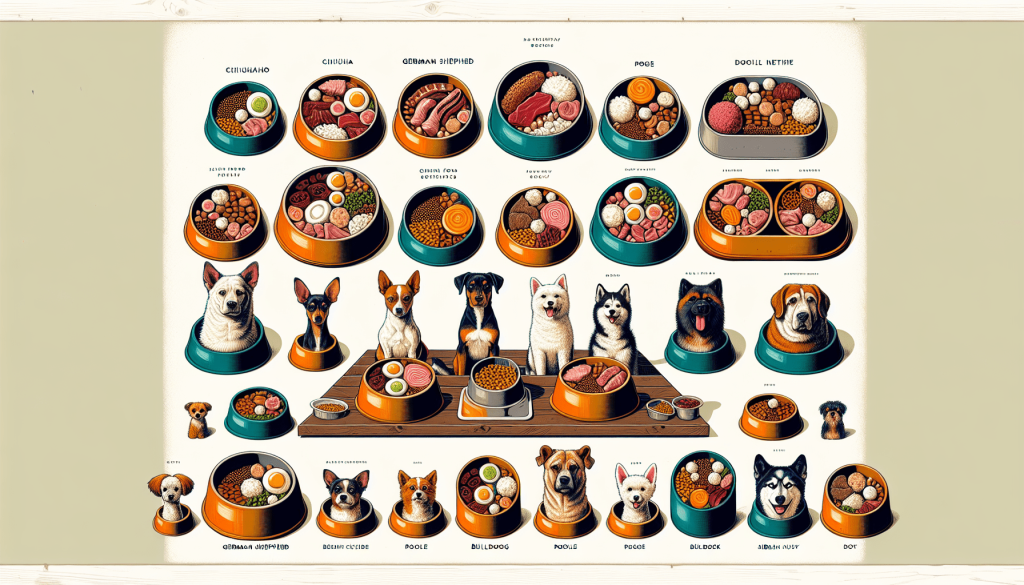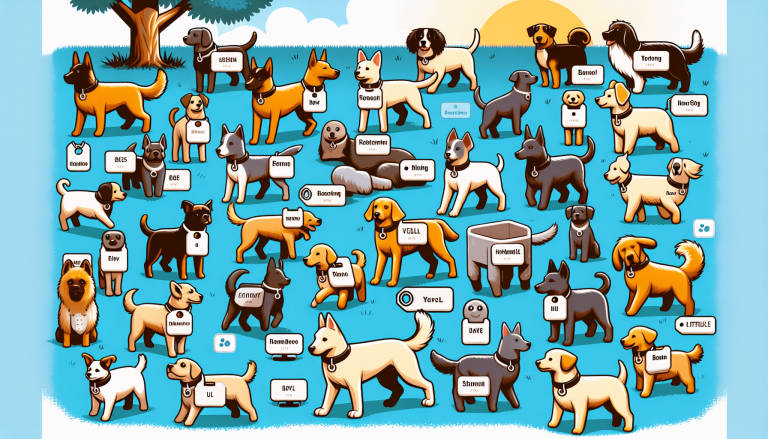Are you unsure about what to feed your furry friend? Look no further, as this article aims to enlighten you on understanding the dietary needs of different dog breeds. Tailoring their diet according to their breed can have significant benefits in maintaining good health and preventing potential health issues. Each breed has unique nutritional requirements, and by having a clear understanding of these needs, you can provide your dog with the best possible care and ensure they live a long, healthy, and happy life.
Table of Contents
ToggleDifferent Nutritional Requirements
Breed-specific dietary needs
Every dog breed has its own unique dietary needs. Factors such as size, activity level, and health conditions play a significant role in determining the nutritional requirements of a particular breed. From small breeds like Chihuahuas to large breeds like Great Danes, understanding the specific needs of your dog’s breed is crucial for their overall health and well-being.
Factors influencing dietary requirements
Several factors influence a dog’s dietary requirements, aside from breed-specific needs. These factors include age, activity level, metabolism, and any underlying health conditions. It’s important to consider all of these factors when determining the appropriate diet for your furry friend. By taking into account these different elements, you can ensure that your dog receives the proper balance of nutrients to thrive.
Size Matters
Comparing small, medium, and large breeds
When it comes to size, different breeds have varying nutritional demands. Small breeds typically have higher metabolisms, requiring more frequent, smaller meals to maintain their energy levels. Medium breeds fall somewhere in between small and large breeds in terms of dietary needs, while large breeds tend to have slower metabolisms and may require fewer calories per pound of body weight.
Adjusting portion sizes based on breed size
Portion control is essential when it comes to feeding dogs of different sizes. It’s important to adjust portion sizes according to your dog’s breed. For small breeds, smaller meals throughout the day can prevent obesity and keep their energy levels stable. Medium breeds may require two to three moderate-sized meals per day. Large breeds, however, may do well with larger, less frequent meals to maintain a healthy weight.
Puppy vs. Adult Diets
Nutritional needs during growth stages
Puppies have unique nutritional needs due to their rapid growth and development. They require more protein, fat, and essential nutrients to support their growing bodies. Foods specifically formulated for puppies are designed to provide these essential nutrients in the right balance. As your puppy grows, their dietary needs will gradually change, so it’s important to transition them to an adult diet at the appropriate time.
Transitioning to adult diets
Around one year of age, most puppies are ready to transition to an adult diet. It’s important to make this transition gradually, over the span of a few weeks, to avoid any digestive issues. Start by mixing a small amount of the new adult food with their puppy food and gradually increase the proportion of adult food while decreasing the puppy food. This gradual transition ensures that your dog’s digestive system adjusts smoothly to the new diet.
Sensitive Stomachs and Allergies
Identifying food sensitivities
Just like humans, dogs can develop sensitivities or allergies to certain ingredients in their food. Common signs of food sensitivity or allergy include itching, skin irritation, digestive upset, and ear infections. If you suspect that your dog has a sensitive stomach or food allergy, it’s important to consult with your veterinarian. They can help you identify the specific ingredient causing the issue and recommend an appropriate diet for your dog.
Choosing hypoallergenic diets
Hypoallergenic diets are specifically formulated to minimize the risk of triggering food sensitivities or allergies. These diets often contain novel protein sources like venison or duck and alternative carbohydrate sources like sweet potatoes or rice. By eliminating common allergens such as chicken, beef, or grains, hypoallergenic diets can help alleviate symptoms in dogs with food sensitivities.
Activity Levels and Energy Needs
High-energy breeds
Some breeds, like Border Collies and Siberian Huskies, are known for their high energy levels. These dogs require diets that provide optimal nutrition to support their active lifestyles. Foods formulated for high-energy breeds often contain higher levels of protein and fat to help sustain their energy levels throughout the day. Regular exercise and mental stimulation are equally important for these breeds to keep them happy and healthy.
Determining calorie requirements
The number of calories a dog needs daily depends on their activity level, age, and size. It’s important to consult with your veterinarian to determine the appropriate calorie intake for your dog. They can help calculate the specific number of calories needed based on your dog’s individual needs. This information will ensure that you are feeding your dog the right amount to maintain a healthy weight.
Health Conditions and Dietary Considerations
Genetic predispositions
Certain dog breeds have genetic predispositions to certain health conditions. For example, large breeds like Golden Retrievers are prone to hip dysplasia, while Bulldogs may have respiratory issues. These genetic predispositions can affect a dog’s dietary needs. Special diets formulated for specific health conditions can help manage and prevent these issues. Consulting with your veterinarian can provide valuable insight into the appropriate diet for your dog breed’s specific health concerns.
Managing specific health conditions
In addition to genetic predispositions, dogs may develop various health conditions throughout their lives. These conditions can often be managed or supported through proper diet. For example, dogs with kidney disease or diabetes may require special diets low in phosphorus and carbohydrates, respectively. Working closely with your veterinarian will ensure that your dog’s diet is optimized to support their specific health needs.
Age-related Dietary Adjustments
Special considerations for senior dogs
As dogs age, their nutritional needs change. Senior dogs typically have lower energy levels and slower metabolisms, so they require fewer calories. Additionally, senior dogs may have specific health concerns that need to be addressed through their diet. Foods formulated for senior dogs often contain joint-supporting ingredients and are lower in fat to accommodate their reduced activity levels.
Senior-specific diets
Senior-specific diets are designed to meet the unique nutritional requirements of older dogs. These diets typically have higher levels of antioxidants, vitamins, and minerals to support their aging bodies. They may also contain ingredients such as glucosamine and chondroitin to promote joint health. Senior dog food options are available in various forms, including dry kibble, canned food, and freeze-dried options. Choosing the right senior diet will help ensure your dog’s well-being in their golden years.
Breed-specific Feeding Guidelines
Specific dietary recommendations for popular breeds
Different dog breeds have different dietary needs, and it’s important to take those into consideration when choosing their food. Some breeds, like the Dachshund, are prone to weight gain, so portion control is crucial. Others, like the Boxer, have a higher risk of developing heart issues, so diets low in sodium can help manage the condition. Understanding the specific dietary requirements for popular breeds can help you make informed choices when it comes to feeding your furry friend.
Feeding schedules
Establishing a regular feeding schedule is important for dogs of all breeds. Most dogs thrive on consistent meal times, as it helps regulate their digestion and prevents overeating. Puppies generally require more frequent meals, while adult dogs can typically be fed two meals per day. By establishing a feeding routine, you can ensure that your dog receives their meals at the same time each day, promoting good digestive health and overall well-being.
Commercial Dog Food Options
Understanding dog food labels
When choosing a commercial dog food, it’s important to understand how to read and interpret the labels. Look for labels that meet the standards set by the Association of American Feed Control Officials (AAFCO). These labels indicate that the food has undergone rigorous testing to ensure it meets the nutritional requirements for dogs. Additionally, familiarize yourself with the ingredients list to ensure that the food contains high-quality protein sources and avoids artificial additives or fillers.
Choosing the right commercial diet
With so many options available, choosing the right commercial diet can feel overwhelming. It’s important to consider your dog’s individual needs, such as age, activity level, and any specific health conditions. Consulting with your veterinarian can help narrow down the options and find a commercial diet that meets your dog’s nutritional requirements. Remember that the quality of ingredients, appropriate nutrient balance, and the reputation of the brand are all crucial factors to consider when selecting a commercial dog food.
Homemade and Raw Diets
Benefits and risks of homemade diets
Homemade diets offer the advantage of being able to control and select specific ingredients for your dog’s meals. By preparing the food yourself, you can avoid potential allergens or irritants and customize the diet to suit your dog’s preferences. However, homemade diets can be challenging to formulate correctly. It’s essential to consult with a veterinary nutritionist to ensure that the diet provides all the necessary nutrients in the proper proportions.
Raw food diet considerations
Raw food diets, also known as BARF diets (Biologically Appropriate Raw Food), are becoming increasingly popular. These diets consist of raw meat, bones, fruits, and vegetables. However, it’s important to recognize that there are potential risks associated with feeding raw food, such as bacterial contamination and nutrient imbalances. Before deciding to feed your dog a raw food diet, it’s important to thoroughly research and consult with your veterinarian to ensure that you are providing a balanced and safe diet for your furry friend.
In conclusion, understanding the dietary needs of different dog breeds is vital for their overall health and well-being. Breed-specific dietary needs, size considerations, age-related adjustments, health conditions, and activity levels all play a role in determining the appropriate diet for your dog. Whether you choose a commercial diet or opt for a homemade or raw food diet, consulting with your veterinarian is crucial to ensure your dog receives the proper balance of nutrients. By providing the right diet, you can help your furry companion lead a happy and healthy life.








